All Nonfiction
- Bullying
- Books
- Academic
- Author Interviews
- Celebrity interviews
- College Articles
- College Essays
- Educator of the Year
- Heroes
- Interviews
- Memoir
- Personal Experience
- Sports
- Travel & Culture
All Opinions
- Bullying
- Current Events / Politics
- Discrimination
- Drugs / Alcohol / Smoking
- Entertainment / Celebrities
- Environment
- Love / Relationships
- Movies / Music / TV
- Pop Culture / Trends
- School / College
- Social Issues / Civics
- Spirituality / Religion
- Sports / Hobbies
All Hot Topics
- Bullying
- Community Service
- Environment
- Health
- Letters to the Editor
- Pride & Prejudice
- What Matters
- Back
Summer Guide
- Program Links
- Program Reviews
- Back
College Guide
- College Links
- College Reviews
- College Essays
- College Articles
- Back
History of Vocaloids
Electronic music. You either hate it or love it. It is either the most genius idea that allows for anyone to create music or a terrible sham that lets talentless geeks to produce trash. These highly polarized opinions tend to originate from the fact that electronic music often features sounds and instruments that are very different from traditional sounds and instruments. However, with the rise of Youtube, Soundcloud, and other online music sharing platforms, even the jarring sounds of synthesizers and other electronic effects are becoming more normalized and known. But, were you aware that electronic singing was a thing?
Vocaloids is a program that produces computerized singing. It essentially strings syllables together to a melody. Popular in Japan and other Asian countries, Vocaloids was originally produced in Spain and was not meant to be a commercial product at all. Called “Frequency-domain Singing Articulation Splicing and Shaping” it was simply meant to advance knowledge of computer limitations. However, Yamaha saw potential in the program and released it as a commercial product in 2003 to Japan.
Vocaloids’ early stages were quite rough. It was released with two “singers” named LEON and LOLA. Clunky and vaguely British sounding, the singers did not appeal to their audience. However, Vocaloid powered on. Vocaloids then proceeded to launch another singer called MEIKO who not only was more natural and familiar sounding, but was also paired with an illustrated character that appealed to audiences. After the success of MEIKO, KAITO was released. It was a flop. However, Vocaloid’s success was right around the corner.
In 2007, Vocaloid2 was to be launched. With it, a character named Hatsune Miku was featured. Unlike previous singers, her voice sounded much less formal. This and her distinct illustrated look of a young girl with long blue pigtails made her into a star. When Yamaha loosened its copyright restrictions, amateurs created a multitude of songs with the software, including the song that now basically represents Vocaloids, World is Mine.
After Miku’s immense success, many other voices were created such as Kagamine Len/Rin and Megurine Luka. Video games were created and concerts are presented around the world where animations of the singers are projected onto a glass sheet to give the illusion that the audience is watching an actual singer instead of a computer program.
Today, Vocaloids are a huge sensation, at least in Japan. With singers that never get tired and that have an infinite vocal range, long series of songs have been created accompanied by plot. Figurines and other merchandise have been produced. Vocaloids has become its own culture point that people rally behind.
One of the hit series was the Story of Evil. A groups of 9 songs, it tells the story of a pair of twins, one the evil queen of a kingdom and the other her loyal servant. The songs focus on themes of good and evil, along with the 7 sins. It also features many plot twists that are a staple in Vocaloid stories. These dramatic plots can also be said to distract listeners when the voices may sound less than natural.
With these stories, the characters became more than just singers. Fans started to develop personalities for the characters. Often, characters would have a few different personalities for different genres or tones of songs. For example, Miku is either known as a sweet, shy girl who loves music or as a slightly bossy drama queen, and Ren is either know as a fun loving kid or as a creepy child. While specifics might be changed in songs, these personalities become basic frameworks that allow for anyone to create not only communal music, but also a communal story.
In a world where more and more things are becoming electronized, Vocaloids could very well be the future. Although the program has yet to take off in the western market, this might change sooner than you think. Love them or hate them, electronic alternatives to traditional music production are here to stay. Electronics aren’t to be feared; it can open new doors to creativity. After all, it’s the same genres in new clothes.

Similar Articles
JOIN THE DISCUSSION
This article has 0 comments.
